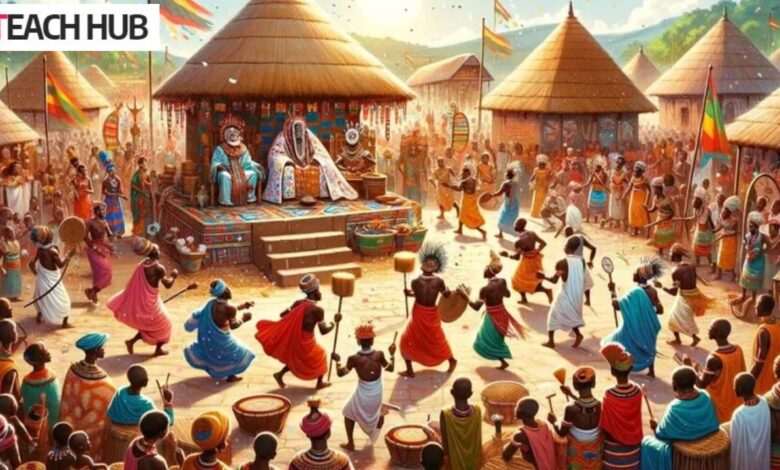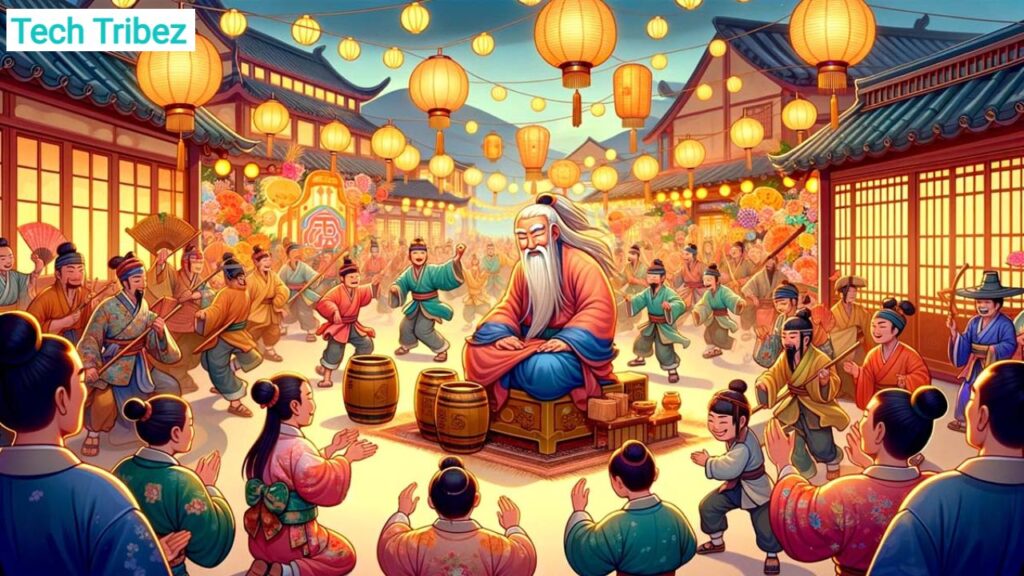Unravelling the Mysteries of Mamgatoto: A Closer Look into Its Relevance in the Cultural Experience and Its Escapades

Mamgatoto is a living cultural agenda where ethical content intermingles with other artistic and narrative values, formulating the populous culture of the community. With a cultural focus imprinted in the people’s belief systems, Mamgatoto presents cultural interactions through visible cultural samples and practices such as arts and sharing the substance of food in the congregation. Such performances give enthusiasts a deep appreciation of their antecedents, allowing them to feel like they are a part of society. As the various activities concerning Mamgatoto are undertaken, they recall their shared history as a community and socialization to modernity.
There is no better reason for the continued existence of Mamgatoto than its importance as an essential social platform that should foster interaction among them to produce harmony in society and among different generations. People can change traditions with time, and this is seen in the given context. Hence, it is pertinent that Mamgatoto is alive to date to impact the audience, both tourists and the inhabitants.
Why Is Mamgatoto a Cultural Phenomenon?
Mamgatoto is considered a sociocultural product because of its distinct capacity to transform individual and collective fashion, meaning, and aesthetic sensibilities. It goes beyond tradition and serves as a culture where the local people live their daily lives employing historical lessons and traditions in their present world. At the heart of Mamgatoto is the idea of the congregation as people join hands to affirm aspirations, values, or processes. Such togetherness creates unity and identification among fellow members, thus making Mamgatoto an essential element in community heritage.
Furthermore, Mamgatoto has also been flooded on international forums, and tourism and research centres themselves on the centre from cultural differences shops. This exposure has taken the status of this phenomenon even higher and has made it possible to engage in cross-cultural diversification and enhance the overall phenomenon. In its constant evolution and sustainability, Mamgatoto is an ever-living example of the essence of culture in creating relations among people.
What Are the Historical Roots of Mamgatoto?
This paper found that the cultural heritage of Mamgatoto is overt, and its origin is rooted among the indigenous people and their folklore. Dating back many generations ago, Mamgatoto was mainly performed to celebrate life events, climatic events, and calendar milestones and achievements by all the community stakeholders. The practice shows society’s appreciation of nature and the power of spirituality that comes with centuries of learning. These roots consist of terms such as rituals, narrations, and arts as tools that educate and help to uphold cohesiveness within societies. Mamgatoto has gradually integrated features of other cultures, which has led to its evolution into a distinct culture that conserves the principal characteristic features. This story draws on people’s history and ability to grow while maintaining definitive features of their culture that reflect their history and traditions.
When Did Mamgatoto Traditions Emerge and Evolve?
Mamgatoto tradition started as early as the 15th century from the social and religious aspects of the Indigenous peoples. Initially, it connected with agricultural cycles and social functions to express solidarity and celebrate nature’s gifts. The element of Mamgatoto also kept changing over the years depending on the interaction of the people with other ethnic groups and changes in the political systems over the years. Another situation was associated with changes that began with the onset of colonialism and active globalization:
Mamgatoto began to accept foreign elements and simultaneously tried to remain loyal to itself. Thus, the transformation of Mamgatoto shows the evolution process, where traditional shows are remodelled according to modern times. This flexibility has set up Mamgatoto for success, enabling the dolls to remain fixtures in today’s cultural fabric.Despite incorporating contemporary elements into the tradition, the latter has gained new depth and become comprehensible today.
What Are the Key Rituals Associated with Mamgatoto?

Elements such as dance, work songs, and turning are crucial in culture and are part of the ritual for the Mamgatoto group. These are observed as everyday meals, recounting lore, and art recreations to strengthen group cohesion. A typical ceremonial activity is meeting the community’s people to perform the rites designed to call for the ancestors’ blessings. One more component is movement, which is possible in dance and music, reflecting and, at the same time, celebrating.
Traditional craft activities are observed in the study, providing a quality way of passing knowledge from one generation to another. Further, during these rituals, children get involved actively, thus helping to maintain contact with the Mamgatoto community’s elders. These rituals, besides asserting cultural branding, are forms of negotiating social learning dialogue and shared experiences that would continue to keep a culturally vibrant and present city in Mamgatoto.
Why Is Mamgatoto Important for Local Identity?
Consequently, Mamgatoto becomes an important avenue through which local identity is defined and taught through the positive aspects of the community’s culture. In this regard, religion plays the social cohesion function by presiding over happenings acceptable to community members by reciting acceptable scriptural passages and narrating events that bind people together. As the world advances and becomes one, Mamgatoto assumes a cultural role of transmitting the customs and beliefs that characterize such a society.
It engages people in the culture of their forefathers and makes them embrace their worth, thus encouraging young people to embrace the culture of their elders. Also, for Mamgatoto, there is the ability to network with different groups while appreciating different viewpoints. As a cultural phenomenon, it adds value to the local environment and places the community in the sphere of understanding cultural diversity. Finally, Mamgatoto plays a crucial role in keeping tradition and identity alive during the transformation of society.
What Challenges Does Mamgatoto Face in Preservation?
Here, the following challenges affect the preservation of Mamgatoto despite its cultural importance: Developing tendencies, such as the increased rate of urbanization and globalization, present some challenges to the continuity of traditional practices, as young people, who are exposed to the new trends, might reject the cultural values of their ancestors. It may result in a decline of people engaging in the mamgatoto activities and other ceremonies associated with those; coming to a close, the societal-related aspects that are vital in the activity may be lost. However, from outside interference, cultural tourism can also want to infringe on Mamgatoto through commercialization since it intends to turn cultures into commodities to be bought.
The problem in this situation is how an organization can adapt while maintaining its fundamental values and activities. Additionally, inadequate material and human resources, capacities, and opportunities for community participation in supporting and sustaining Mamgatoto exist. The mentioned challenges must be tackled by continued cooperation between the local population and outsiders interested in the further development of Mamgatoto for future generations.
How Is Mamgatoto Celebrated Around the World?
Despite having begun in Chikwawa, Mamgatoto has gone international and can be observed elsewhere. They continue to practise celebrations and rituals in one way or another, imitating traditional ones but adapting to the regional circumstances. In many areas of the urban communities, the cultural festivals help to present Mamgatoto through music, dance, and food. This draws many people to explore the artistic legacy. Some tribes celebrate the herbalist, recognizing this unique figure, so Mamgatoto’s performance is every day during social gatherings among communities in the diaspora who want to continue celebrating their roots.
These celebrations preserve culture and produce space for introduction and cultural exchange: people tell their stories and personal observations about Mamgatoto. The other development has also been social media, which has helped take Mamgatoto global via online participation and sharing of cultural items. With Mamgatoto being danced worldwide, it transforms into a worldwide event that celebrates the origins of the dance and the culture of all the people partaking in the event.
What Personal Stories Highlight the Essence of Mamgatoto?
The testimonies related to Mamgatoto are rather personal, with an emphasis on the mission of the show as contributing to the formation of people’s identity and belonging. Most participants report utopian experiences associated with their first encounter with Mamgatoto celebrations and identify positive emotions of community belonging and pride. These accounts focus on the people’s relationships with each other across generations, mentoring, and teaching, especially singing and dancing. For instance, people may narrate how Mamgatoto rituals helped them cope with loss and HIV and AIDS stigma and provided hope during difficult periods. Most such stories centre on cultural preservation issues, showing how Mamgatoto is a vital source of the arm for people desiring their cultural endowment. By sharing these personal stories, one can better understand the very character of Mamgatoto and its abilities to provide hope, restore relationship bonds, and bring hope and understanding to individuals and their cultural heritage.
When Is the Best Time to Visit Mamgatoto for Cultural Experiences?
Cultural tourism experiences are considerably seasonal, and usually, other festivals or ritual seasons in the vicinity of Mamgatoto people. All these events, filled with bright and engaging performances, are great chances to see expected traditions in action. For instance, travellers say they were battered to taste the ripened fruits during harvest since communities organize themselves to share foods and other activities as symbolic renditions of harvest festivals. Further, cultural festivals involving music, dance, drama, and art exhibitions offer tourists an understanding and experience of the culture of Mamgatoto that enables the members to interact with artisans and artists. Visiting the sites during these times improves the experience and helps the locals benefit from cultural tourism. It is recommended to find available printed sources or speak to community leaders to guarantee tourists the overall artistic experience of discovering the lively and colourful Mamgatoto.
How Can Visitors Practice Sustainable Tourism in Mamgatoto?
Tourism can be responsible for the development of Mamatoto by involving the people in a dignified manner. Fewer tourists might be motivated by focusing on local enterprises, including family-owned guesthouses, cafés, restaurants, and craftsmanship stores that contribute to the local economy. Engaging in local-led tours and driving or cycling through the countryside helps tourists interact with people and avoid exerting heavy pressure on nature reserves. Culture is also critical, and everything concerning culture should be respected; one has to be receptive to cultural interactions.
Asking for permission before taking snaps, avoiding taking snaps secretly, and maintaining a low profile voice while performing rituals also help make the ambiance equally conducive. Besides, it is also possible to participate in conservation by volunteering to complete community projects that preserve the cultural and natural resources in the Mamgatoto region. Through such measures, tourists can get several fulfilling experiences while respecting the cultural heritage of Mamgatoto.
Conclusion
In conclusion, Mamgatoto can be depicted as a lively and multifaceted cultural phenomenon with no specific timeframe or geographical location. It is also important not only due to its historical background but also to its prospects in the conditions of the modern world. The primary traditional practices and individual experiences connected with Mamgatoto reveal its purpose of strengthening the community‘s unity and spirit and preserving the cultural experience for posterity. Inasmuch as communities across the globe celebrate Mamgatoto, they build platforms where people can share their cultures, thereby reminding everybody that culture is not a fossil created once and then left to gather dust but is a living process invented over time.” Nevertheless, there is still much to be done in this area, and to ensure the sustainability of this invaluable tradition, the cooperation of the local people and the visitors is highly required. Finally, through Mamgatoto, the story speaks about culture concerning the ancient tradition as a tradition that is alive compared to other traditions.
(FAQs)
What is Mamgatoto?
Mamgatoto can, therefore, be summarised as a form of cultural practice that includes rites, festivities, and artwork associated with cultural heritage and the community.
When did Mamgatoto traditions begin?
This paper outlines the development of Mamgatoto from the 15th century to the present, influenced by intercultural interactions and social transformation processes.
What are the main rituals associated with Mamgatoto?
These are feasting, tale-telling, and other artistic events, which play a central role in assembling the people and continuing their culture.
How does Mamgatoto impact local identity?
Therefore, Mamgatoto helps uphold local cultural practices and promote the people’s inclusion in developing their cultural artefacts.
What challenges does Mamgatoto face?
Some of the remaining threats include urbanization, globalization, and weakening traditional practices in societies.
How is Mamgatoto celebrated globally?
The culture of Mamgatoto is acknowledged globally through festivals recognized across the globe, fairs, and internet platforms.
What personal stories illustrate Mamgatoto’s essence?
Again, the stories of change that she eagerly shares with her audience may focus on cultural engagement and continuity, on maintaining relationships with people of older generations.
When is the best time to visit Mamatoto?
This is particularly true when festivals, festive seasons, or harvests are marked by colourful activities that immerse the visitor.
How can visitors practise sustainable tourism in Mamatoto?
Tourists can purchase from local producers, participate in community-based activities, and stay informed on the culture to be sustainable.
Why is Mamgatoto considered a cultural phenomenon?
Mamgatoto is cultural because of the broad socio political and socio cultural functions it serves. It articulates identity, pride, community, and advocacy for arts.

